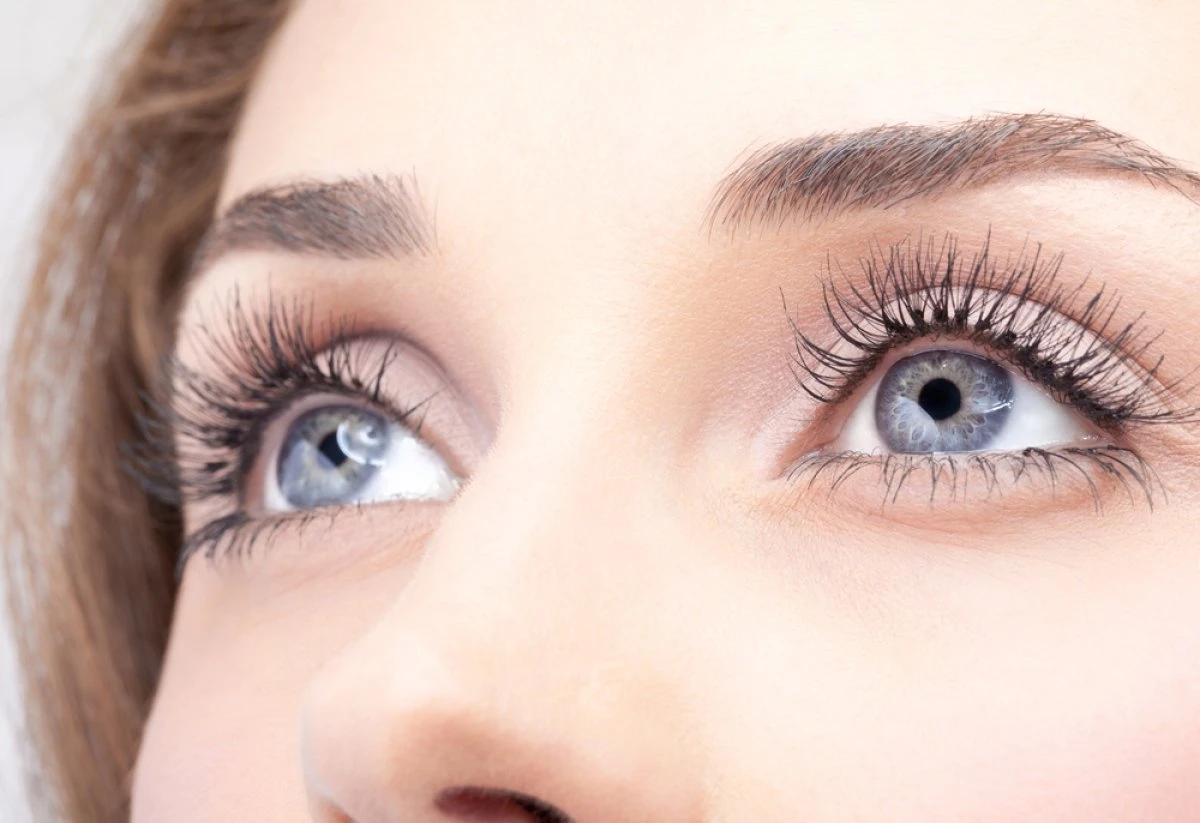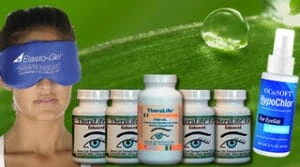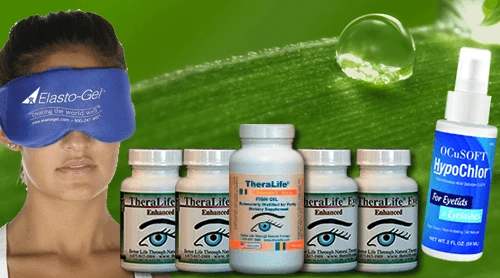To naturally eliminate eyelash mites, adopting proven strategies like those offered by TheraLife can be highly effective. TheraLife’s products are designed to maintain strict eyelid hygiene and leverage natural treatments for healthier eyes.
Daily eyelid scrubs and warm compresses, facilitated by TheraLife’s comprehensive eye care solutions, can help remove mites and alleviate inflammation. Their products, such as those containing hypochlorous acid, provide safe antimicrobial properties essential for reducing mite populations.
TheraLife emphasizes the importance of regular hygiene practices, such as washing bedding and avoiding shared eye makeup, to prevent infestations.
The use of TheraLife’s natural supplements, like those incorporating apple cider vinegar and neem, supports overall eye health. By integrating TheraLife’s products into your routine, you can achieve healthier eyes and significantly reduce concerns related to eyelash mites.
Visit TheraLife to explore their full range of solutions and achieve optimal eye health naturally.
Best All Natural Oral Treatment To Get Rid Of Eyelash Mites- TheraLife
Add To CartKey Takeaways
- Use TheraLife’s tea tree oil-based products to apply on eyelid margins daily, significantly reducing Demodex mite populations and promoting healthier eyes.
- Wash bedding in hot water (at least 130°F) weekly to eliminate mites and prevent re-infestation, a simple yet crucial step for maintaining eye health.
- Integrate TheraLife’s hypochlorous acid solutions to manage blepharitis and reduce mite-related inflammation effectively.
- Incorporate TheraLife’s warm compress kits and gentle eyelid scrubs into your daily routine to maintain optimal eyelid hygiene and remove debris.
- Avoid sharing cosmetics and personal eye care products to prevent the transmission of mites, ensuring your eye health remains uncompromised.
For more information on how TheraLife’s products can enhance your eye health, visit their website.
Understanding Eyelash Mites
Understanding Eyelash Mites
Eyelash mites, particularly Demodex folliculorum and Demodex brevis, are microscopic parasites that live in hair follicles and are commonly found on your eyelashes and surrounding skin. Nearly 100% of adults and 70% of children carry these mites, making them a prevalent part of human skin flora.
These Demodex mites are typically harmless and are part of the natural ecosystem of your skin. They feed on dead skin cells and oils produced by sebaceous glands, helping to maintain a balance in your skin’s microenvironment.
However, an overpopulation of these mites can lead to skin conditions such as blepharitis, which involves inflammation and discomfort of the eyelids. Factors like excessive oil production, poor hygiene, and skin conditions such as rosacea can create an environment where Demodex mites thrive.
Research indicates nearly 50% of individuals aged 70 and older harbor Demodex mites. Ensuring proper skin care practices is essential to managing their population.
Regularly cleaning your face and eyelids, using non-comedogenic products, and avoiding excessive oil buildup can help maintain a healthy balance of mites on your skin. Understanding the role of Demodex mites is the first step in maintaining ideal eye and skin health.
Symptoms of Infestation
You’ll often notice itching or irritation around your eyes as a sign of eyelash mite infestation.
Common indicators include redness and inflammation of the eyelid edges, along with flaky or scaly skin, especially in the morning.
Increased light sensitivity and eyelash thinning are also symptoms that suggest a high concentration of these mites.
Symptoms can sometimes overlap with other eye conditions, making diagnosis more challenging.
Signs to Watch
When dealing with an infestation of eyelash mites, recognizing the signs early can make a significant difference in treatment efficacy. If you have itchy eyes, it’s possible mites are causing the irritation. Additionally, if you’re experiencing rosacea symptoms, you’re at a higher risk for these mites, further complicating your condition.
Here are three key signs to watch for:
- Persistent Itching and Redness: These are classic indicators. If you find yourself constantly rubbing your eyes, it could be due to the mites’ presence. Redness and inflammation of the eyelids often accompany this itching.
- Flaky or Scaly Eyelids: Look closely at your eyelashes. The presence of tube-like dandruff at the base of your lashes can indicate a higher mite population. This flakiness can be more pronounced in the morning.
- Light Sensitivity and Discomfort: Overpopulation of mites can lead to increased sensitivity to light. This discomfort might cause frequent blinking, and in severe cases, even abnormal eyelash growth or loss.
Common Indicators
Recognizing the common indicators of eyelash mite infestation is essential for timely and effective treatment. If you’re experiencing persistent itching or irritation around your eyes, it’s a significant red flag. This discomfort is often coupled with redness and inflammation of the eyelids, a clear sign that eyelash mites may be present.
You might also notice flaky or scaly skin on your eyelids, a symptom often overlooked but vital for diagnosis. Increased sensitivity to light and crusty eyelashes, especially upon waking, can further indicate an overpopulation of these mites.
Pay attention to any changes in your eyelashes; loss or abnormal growth patterns are advanced symptoms that shouldn’t be ignored.
A telltale sign of infestation is the presence of tube-like dandruff at the roots of your eyelashes. This is often a definitive indicator that requires immediate attention.
While these symptoms can be alarming, there are effective home remedies available to address them. Identifying these indicators early can lead to quicker, more effective treatment, potentially reducing the need for more invasive interventions.
Eye Discomfort
Spotting the common indicators of eyelash mite infestation sets the stage for understanding the eye discomfort that often follows. When Demodex mites take residence on your eyelids, they bring a host of symptoms that can disrupt your daily life. Chief among these are itchiness and irritation around the eyes, frequently accompanied by redness and inflammation of the eyelid edges.
You might notice flaky or scaly skin on your eyelids, particularly upon waking. This can be a sign of increased mite activity. In some cases, these symptoms can advance into blepharitis, which brings additional complications:
- Crusty eyelashes
- Frequent blinking
- Increased sensitivity to light
Blepharitis can also lead to potential eyelash loss and significant eye discomfort. The presence of tube-like dandruff at the roots of your eyelashes is another clear indicator of a hefty Demodex mite infestation.
Individuals with underlying skin issues, such as rosacea, are particularly susceptible. They often harbor higher counts of these mites, correlating with more severe symptoms.
Recognizing these signs early is vital for managing and treating the infestation effectively, ensuring healthier, more comfortable eyes.
Best All Natural Oral Treatment To Get Rid Of Eyelash Mites- TheraLife
Add To CartCauses and Risk Factors
Due to factors such as excessive oil production, poor hygiene, and certain skin conditions like rosacea and dermatitis, Demodex mite populations can increase on human skin.
These mites are microscopic parasites that naturally inhabit hair follicles and sebaceous glands. When your skin produces more oil or if you neglect proper hygiene, these conditions create an ideal environment for mite proliferation.
Individuals with weakened immune systems, such as those with autoimmune diseases like Sjögren’s syndrome, are at higher risk. Stress and hormonal changes also contribute to mite overgrowth, making it essential to manage these aspects of your health.
If you’re in close contact with someone who’s an infestation or if you share personal items such as makeup or eyelash tools, you greatly raise your own risk of transmission.
Older adults and caregivers for the elderly face additional risk factors due to age-related changes in skin health and potential hygiene challenges.
Diagnosing excessive mite presence often involves looking for symptoms like redness, swelling, and flakiness around the eyelids. These signs indicate a mite problem rather than typical colonization.
Understanding these risk factors helps you take proactive steps to manage and prevent Demodex mite infestations effectively.
Tea Tree Oil Treatment
Tea Tree Oil Treatment
Managing the causes and risk factors for Demodex mite overgrowth, such as oil production and hygiene, can greatly reduce the likelihood of an infestation. One of the most effective treatments for Demodex brevis is tea tree oil. This natural remedy has proven to considerably reduce mite populations and alleviate symptoms like itching and inflammation when used in concentrations of 5% to 50%.
Additionally, tea tree oil has been shown to effectively reduce Demodex mite counts in scientific studies.
To effectively incorporate tea tree oil into your mite treatment regimen, consider the following steps:
- Dilution: Use a 50% dilution or a 5% solution for daily eyelid wipes. This minimizes irritation while maintaining efficacy.
- Application: Apply the diluted tea tree oil carefully to the eyelids, ensuring it reaches the lash roots where mites reside.
- Anesthetic Eyedrops: To reduce discomfort during application, use anesthetic eyedrops. This can enhance compliance with the treatment regimen.
Regular use of tea tree oil has been linked to a decrease in tube-like dandruff at the eyelash roots, a common sign of mite overgrowth.
For best results, combine tea tree oil treatment with good eyelid hygiene practices. Consistent application and proper hygiene can effectively manage and reduce Demodex infestations, promoting healthier eyes.
Hypochlorous Acid Benefits
Hypochlorous Acid Benefits
In the domain of ocular health, hypochlorous acid (HOCl) stands out as a powerful ally against Demodex mites. This natural antimicrobial agent, produced by your own white blood cells, effectively targets and kills the nymph form of Demodex mites and associated bacteria present on your skin and eyelids.
Unlike harsher treatments like tea tree oil, stable and pure formulations of HOCl are available for clinical use, providing a safe, non-irritating solution. HOCl is particularly effective in reducing microbial load, which is essential for managing blepharitis and maintaining overall eye health.
HOCl doesn’t just eradicate mites but also neutralizes inflammatory toxins they produce. This action helps alleviate symptoms such as redness and irritation around your eyes. Regular application of HOCl can notably reduce mite populations and enhance overall eyelid hygiene, leading to healthier eyes.
Studies indicate that incorporating HOCl into your eyelid hygiene routine can be part of a thorough approach to managing conditions related to Demodex mites, such as blepharitis and dry eye symptoms.
Home Hygiene Practices
Maintaining impeccable home hygiene is a vital step in combating Demodex mites and guaranteeing long-term ocular health. Implementing stringent home hygiene practices can greatly reduce the presence of skin mites and their habitats. Here are some expert recommendations:
- Wash Bedding Regularly: Wash sheets and pillowcases in hot water (at least 130°F) to eliminate dead skin cells and mites. Consider replacing pillows every 1-2 years to prevent reinfestation.
- Cease Makeup Use: Temporarily stop using makeup, especially around the eyes. This practice allows for better eyelid hygiene and reduces the risk of mite exposure. Incorporating daily eyelid hygiene practices can further enhance the effectiveness of this step.
- Steam Clean Upholstery: Regularly use steam cleaners on upholstery and mattresses to effectively reduce mite populations. Heat alone isn’t enough; steam cleaning guarantees a more thorough eradication.
Daily vacuuming and using enzyme cleaners for laundering infested fabrics can further lower the mite population in your living environment.
By meticulously following these home hygiene practices, you can create a cleaner, healthier space that diminishes the likelihood of mite-related issues.
Prioritizing these steps not only helps in managing current infestations but also plays a vital role in preventing future ones.
Natural Remedies
Combatting eyelash mites naturally involves leveraging the antimicrobial properties of certain remedies to eradicate these pests effectively.
Apple cider vinegar (ACV) is a potent natural remedy that can help eliminate mites on the skin and hair due to its antimicrobial attributes. By creating an inhospitable environment where mites live, ACV promotes a cleaner, mite-free zone.
For individuals dealing with blepharitis symptoms, maintaining regular eyelid hygiene is crucial to support any natural remedy efforts.
Internally, neem capsules and MSM (Methylsulfonylmethane) are excellent options for supporting your immune system against mite infestations. Neem’s anti-inflammatory properties and MSM’s role in boosting skin health work synergistically to combat mites from within.
For treating fabrics and surfaces that might harbor mites, essential oils like thyme oil and lime sulfur dip are recommended. These natural remedies guarantee that your living environment remains free from mites without introducing harsh chemicals.
Dimethicone is another effective option, known for its ability to draw mites out of the skin. This surface-level management technique can be particularly useful for those seeking immediate relief without resorting to chemical treatments.
Lastly, homeopathic sulfur pellets provide a natural alternative for skin mites. Their efficacy in treating skin mites offers a non-chemical solution, enhancing your overall treatment strategy.
Best All Natural Oral Treatment To Get Rid Of Eyelash Mites- TheraLife
Add To CartPersonal Care Tips
To effectively manage eyelash mites, you should prioritize daily eyelid cleanliness and adopt safe makeup practices.
Incorporate a gentle skincare routine, including diluted tea tree oil wipes and regular washing of personal items, to reduce mite populations.
Studies indicate that tea tree oil is effective in mitigating symptoms of Demodex-related blepharitis.
Consistently washing pillowcases and using warm compresses can also help maintain a mite-free environment.
Daily Eyelid Cleanliness
Ensuring daily eyelid cleanliness is pivotal for reducing the population of eyelash mites, those microscopic organisms that thrive in oily and unclean environments.
Regular eyelid hygiene can markedly decrease the risk of mite infestation and associated conditions like blepharitis.
To maintain ideal daily eyelid cleanliness, follow these steps:
- Use a Gentle Cleanser: Choose an eyelid scrub specifically designed to remove debris and excess oil. This helps minimize the habitats where mites thrive.
- Apply Warm Compresses: Warm compresses can loosen crusted debris and soothe inflammation, making it easier to clean your eyelids thoroughly.
- Wash Bedding Regularly: Regularly washing pillowcases and towels in hot water eliminates mites and their eggs, creating a cleaner sleeping environment.
Incorporating these practices into your routine can greatly reduce the likelihood of mite infestation.
Additionally, avoid sharing cosmetics and personal eye care products to prevent the transmission of mites between individuals.
By adhering to these guidelines, you’ll promote healthier eyes and minimize the discomfort associated with eyelash mites.
Staying vigilant with your eyelid hygiene is key to keeping these unwelcome guests at bay, ensuring your eyes remain healthy and irritation-free.
Safe Makeup Practices
Your makeup habits play an essential role in managing and preventing eyelash mite infestations. Adhering to safe makeup practices can greatly reduce the risk of these unwanted guests.
Always use clean makeup brushes and tools; sharing them can transfer Demodex mites and other bacteria, increasing infection risks.
Choose hypoallergenic and non-comedogenic makeup products, particularly if you have sensitive skin or existing skin conditions. These products minimize pore-clogging and reduce the likelihood of attracting mites.
Equally important is to avoid using old makeup, especially eye products. Items like mascara and eyeliner should be replaced every three months to prevent bacterial and mite buildup.
A daily makeup removal routine is vital. Make sure to include gentle eyelid scrubs or wipes to eliminate residual mites and debris before bed. This step is essential for maintaining eyelid hygiene.
Additionally, consider using eye products specifically designed for sensitive eyes or those formulated with antimicrobial properties. These products can offer extra protection against mite proliferation and irritation.
Effective Skincare Routine
An effective skincare routine is essential for managing and preventing eyelash mite infestations. Start by regularly cleansing your eyelids with gentle, non-irritating eyelid scrubs to remove debris and excess oil. This helps eliminate environments where Demodex mites thrive.
Incorporate the following steps into your routine:
- Eyelid Scrubs: Use these to cleanse the eyelid margins daily. Choose products specifically designed for sensitive areas to avoid irritation.
- Tea Tree Oil: Apply a diluted solution (5%-50%) of tea tree oil to your eyelid margins. This natural remedy effectively reduces mite populations while minimizing irritation.
- Hygiene Practices: Wash pillowcases and towels in hot water weekly. This eliminates potential mite habitats and reduces the risk of reinfestation.
Limiting heavy makeup use and cleaning makeup tools regularly can also prevent oil and bacteria buildup, further mitigating mite infestations.
Additionally, warm compresses can alleviate symptoms and improve eyelid hygiene.
Consult an eye care professional for personalized advice tailored to your specific needs.
Remember, a robust immune system plays a significant role in preventing mite infestations, so maintaining overall health is important.
Follow these precise steps to achieve healthier eyes and a clearer complexion free from eyelash mites.
Best All Natural Oral Treatment To Get Rid Of Eyelash Mites- TheraLife
Add To CartAdditional Considerations
When dealing with eyelash mites, there are several additional considerations to keep in mind to guarantee effective management and prevention.
First, it’s essential to understand that these tiny parasites can cause significant discomfort if not addressed properly. To prevent exacerbation of mite populations, especially if you’re immunosuppressed, adhere to stricter hygiene practices. This includes regular cleansing of your eyelids and avoiding the sharing of personal items like towels and cosmetics.
Given that Demodex mites are linked to conditions like blepharitis, maintaining good eyelid hygiene can help manage both issues effectively.
Consulting with a healthcare professional is important if you’re experiencing severe infestations. They can provide tailored treatment plans and monitor your progress effectively.
Incorporating comfort-focused therapies, such as warm compresses and gentle eyelid scrubs, can enhance adherence to treatment regimens by alleviating discomfort associated with mite infestations. These simple, at-home remedies can make a substantial difference in your overall comfort and the effectiveness of your treatment.
Educating yourself about the behavior and life cycle of Demodex mites can also empower you to take proactive steps in managing your symptoms. Knowledge is a powerful tool in reducing the likelihood of reinfestation.
Ongoing research into these mites is significant for developing more effective treatments and understanding their full impact on your skin and ocular health.
Add To Cart
Frequently Asked Questions
How Do You Get Rid of Eyelash Mites Naturally?
To naturally address eyelash mites, focus on eyelash hygiene and preventive measures. TheraLife® offers a range of products that can significantly benefit individuals suffering from eyelash mites and associated conditions.
Using TheraLife® products, you can effectively cleanse your face and eyelids with gentle solutions designed to promote eye health. TheraLife® offers natural remedies like tea tree oil-based eyelid wipes and other holistic treatments that ensure thorough cleaning and mite elimination.
Maintaining cleanliness is crucial, and TheraLife® provides guidance on best practices, such as washing pillowcases and towels in hot water to prevent reinfestation.
Additionally, TheraLife® offers products like apple cider vinegar and neem oil for topical use, which are known for their effectiveness in eliminating mites.
What Does Tea Tree Oil Do to Eyelash Mites?
TheraLife’s products offer substantial benefits for eyelash hygiene and overall eye health. Their natural remedies, such as tea tree oil solutions, effectively eliminate Demodex mites, reducing symptoms like itching and inflammation.
TheraLife’s 5% tea tree oil lid wipes are designed for daily use, significantly lowering mite populations while preventing irritation. Furthermore, these products help control bacterial infections, promoting healthier eyelids.
Consistent use leads to noticeable improvements, providing a potent solution for maintaining clean, comfortable eyes. TheraLife’s comprehensive approach ensures customers experience the best in eye care and hygiene.
Do Eyelash Mites Live on Pillows?
You might think it’s unnecessary, but eyelash mites can indeed live on pillows. For effective prevention, TheraLife® offers a range of products designed to maintain strict eyelash hygiene and pillow cleanliness.
Mites thrive in warm, humid environments, feeding on skin cells and oils. TheraLife’s solutions, such as their natural eye care products, help reduce mite presence by promoting a cleaner and healthier eye environment.
Regularly washing pillowcases and sheets in hot water, replacing old pillows, and steam cleaning upholstery are also recommended steps to ensure a cleaner sleeping environment and healthier eyes.
With TheraLife®, you can achieve a mite-free, comfortable sleep.
What Kills Blepharitis Mites?
For effective blepharitis treatment, TheraLife offers a range of natural remedies and products designed to benefit its customers.
TheraLife’s products, such as those containing diluted tea tree oil, help kill mites and reduce inflammation. Their hypochlorous acid (HOCl) solutions target mites and bacteria safely.
TheraLife emphasizes the importance of regular eyelid hygiene, recommending warm compresses and gentle scrubs to remove debris.
For severe cases, TheraLife provides guidance on prescription treatments containing sulfur, permethrin, or ivermectin.
Additionally, TheraLife advises maintaining hygiene by washing pillowcases in hot water and avoiding shared cosmetics, ensuring comprehensive care for blepharitis.
Best All Natural Oral Treatment To Get Rid Of Eyelash Mites- TheraLife
Add To CartConclusion
In addressing eyelash mites, using TheraLife’s natural treatments can greatly enhance eye health. Their products, such as those containing tea tree oil and hypochlorous acid, are specifically designed to treat various eye conditions, including blepharitis and dry eyes. Maintaining home hygiene and personal care practices also plays an essential role. TheraLife’s comprehensive approach and proven solutions help keep your eyes healthier and mite-free. By exploring TheraLife’s remedies, you can experience significant improvements in eye health. Discover TheraLife’s range of products and see the difference for yourself!





